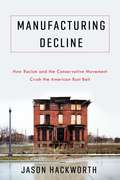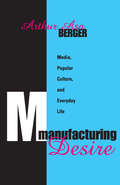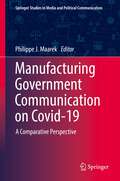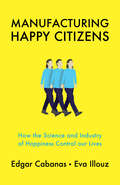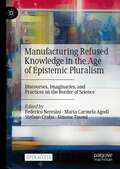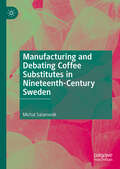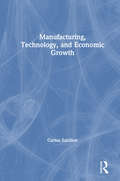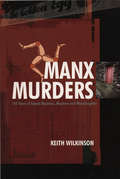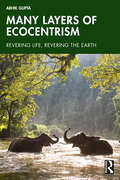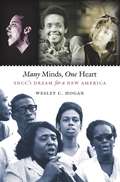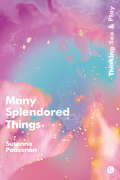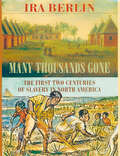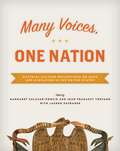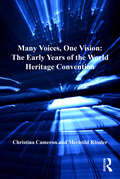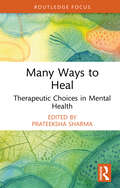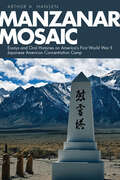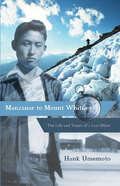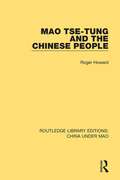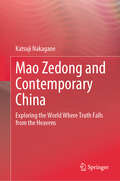- Table View
- List View
Manufacturing Decline: How Racism and the Conservative Movement Crush the American Rust Belt
by Jason HackworthFor decades, the distressed cities of the Rust Belt have been symbols of deindustrialization and postindustrial decay, their troubles cast as the inevitable outcome of economic change. The debate about why the fortunes of cities such as Detroit have fallen looms large over questions of social policy. In Manufacturing Decline, Jason Hackworth offers a powerful critique of the role of Rust Belt cities in American political discourse, arguing that antigovernment conservatives capitalized on—and perpetuated—these cities’ misfortunes by stoking racial resentment.Hackworth traces how the conservative movement has used the imagery and ideas of urban decline since the 1970s to advance their cause. Through a comparative study of shrinking Rust Belt cities, he argues that the rhetoric of the troubled “inner city” has served as a proxy for other social conflicts around race and class. In particular, conservatives have used images of urban decay to craft “dog-whistle” messages to racially resentful whites, garnering votes for the Republican Party and helping justify limits on local autonomy in distressed cities. The othering of predominantly black industrial cities has served as the basis for disinvestment and deprivation that exacerbated the flight of people and capital. Decline, Hackworth contends, was manufactured both literally and rhetorically in an effort to advance austerity and punitive policies. Weaving together analyses of urban policy, movement conservatism, and market fundamentalism, Manufacturing Decline highlights the central role of racial reaction in creating the problems American cities still face.
Manufacturing Desire: Media, Popular Culture, and Everyday Life
by Arthur Asa BergerThe average person in America watches four hours of television per day and spends the equivalent of nine years of his or her life in front of the television set. If the attention most people devote to popular culture - listening to the news, watching soap operas, reading the comics-were added up, it would reveal that most people spend an enormous amount of time with popular culture which becomes in large measure, their culture. "Manufacturing Desire" is a study of how the mass media broadcast or spread various popular arts; further how the media and popular arts play a major role in shaping our everyday lives.The television shows we watch, the movies we see, the radio programs we listen to, and all the comic strips we read influence social behavior. They give us ideas about what is good and evil, about how to solve problems, and about how we should relate to others. If we understand this, says Berger, then the way we think about our media-influenced culture will be far different than if we see popular culture as mindless entertainment. Berger provides an analysis of the way popular culture and the mass media simultaneously reflect and affect various aspects of American culture and society. He examines commercials, television shows, comics, film, humor, and everyday life in terms of what beliefs and values are found in them, what attitudes toward ourselves, and our societies are contained in them, how they achieve their effects, and what they reflect about present-day American culture and society.This book is analysis of the impact mass media have across America, cross-culturally, and internationally. "Manufacturing Desire" will provide the general reader as well as specialists in communication and information, sociology, and psychology with a better understanding of the effects of mass media and popular culture on contemporary society.
Manufacturing Government Communication on Covid-19: A Comparative Perspective (Springer Studies in Media and Political Communication)
by Philippe J. MaarekThis book presents a comparative perspective on different government communication strategies to COVID-19 around the globe. Scholars from twenty parts of the world specialized in political and government communication analyze initiatives and methods of various governments' communicative responses to the pandemic. In their contributions to this volume, they examine a wide range of distinct attitudes and reactions facing the crisis. Today’s omnidirectional contact allowed by social media, with its load of contradictory rumors and fake news, often obliterates the citizens' ability to comprehend reality. The book frames a broad canvas on how government communication may deal with that and manage similar crises — bound to happen as climate changes and war menaces are generating more and more worries about the future of humanity. This makes this volume a must-read for scholars and students of political communication, health policies and communication, crisis marketing and communication. It will also be of utmost interest for practitioners and policy-makers from these fields willing to better understand government communication and its answer to global crises.
Manufacturing Happy Citizens: How the Science and Industry of Happiness Control our Lives
by Eva Illouz Edgar CabanasThe imperative of happiness dictates the conduct and direction of our lives. There is no escape from the tyranny of positivity. But is happiness the supreme good that all of us should pursue? So says a new breed of so-called happiness experts, with positive psychologists, happiness economists and self-development gurus at the forefront. With the support of influential institutions and multinational corporations, these self-proclaimed experts now tell us what governmental policies to apply, what educational interventions to make and what changes we must undertake in order to lead more successful, more meaningful and healthier lives. With a healthy scepticism, this book documents the powerful social impact of the science and industry of happiness, arguing that the neoliberal alliance between psychologists, economists and self-development gurus has given rise to a new and oppressive form of government and control in which happiness has been woven into the very fabric of power.
Manufacturing Mennonites
by Janis Lee ThiessenManufacturing Mennonites examines the efforts of Mennonite intellectuals and business leaders to redefine the group's ethno-religious identity in response to changing economic and social conditions after 1945. As the industrial workplace was one of the most significant venues in which competing identity claims were contested during this period, Janis Thiessen explores how Mennonite workers responded to such redefinitions and how they affected class relations.Through unprecedented access to extensive private company records, Thiessen provides an innovative comparison of three businesses founded, owned, and originally staffed by Mennonites: the printing firm Friesens Corporation, the window manufacturer Loewen, and the furniture manufacturer Palliser. Complemented with interviews with workers, managers, and business owners, Manufacturing Mennonites pioneers two important new trajectories for scholarship - how religion can affect business history, and how class relations have influenced religious history.
Manufacturing Refused Knowledge in the Age of Epistemic Pluralism: Discourses, Imaginaries, and Practices on the Border of Science
by Simone Tosoni Federico Neresini Maria Carmela Agodi Stefano CrabuThis open access book explores contemporary practices that challenge science, arguing that this matter cannot be simply disregarded as a new manifestation of “anti-scientism”. It scrutinizes the processes through which knowledge claims, refused by established institutions and the scientific community, seek legitimacy. Assuming an agnostic analytical stance, it explores the actors involved in such processes and their social worlds, their interactions with epistemic institutions, and the ways in which they enact such refused knowledge in their daily lives. Drawing on a three-year mixed-method research project, this collection demonstrates how refused knowledge can be seen as a distinct mode of knowing, employed in response to the uncertainties of everyday life. Thus, it offers a deeper understanding not only of how refused knowledge garners credibility, but also of how knowledge at large – including scientific knowledge – emerges from specific sociotechnical assemblages.
Manufacturing Terrorism in Africa: The Securitisation of South African Muslims (Islam and Global Studies)
by Mohamed Natheem HendricksThis book uses Securitisation Theory to explore how Muslims have been constructed as a security issue in Africa after the 9/11 attacks in the United States. These attacks became the rationale for the US’s Global War on Terror (GWOT). The centrality of Africa as an arena to execute the GWOT is the focus of this book. This book explores, particularly, how western-centred security discourses around Muslims has permeated South African security discourse in the post-apartheid period. It claims that the popular press and the local think-tank community were critical knowledge-sites that imported rather than interrogated debates which have underpinned policy-initiatives such as the GWOT.Such theorisation seems contrary to the original architects of securitisation theory who maintain that issues become security concerns when institutional voices declare these as such. However, this book confirms that non-institutional voices have securitised the African Muslims by equating them with terrorism. This book illustrates that such securitisation reproduces partisan knowledge that promote Western interests.
Manufacturing and Debating Coffee Substitutes in Nineteenth-Century Sweden
by Michal SalamonikThis book explores the development of coffee substitutes in nineteenth-century Sweden. In doing so, it considers the the threshold between the preindustrial and industrial periods by analyzing trade, consumption, social, economic, and environmental changes, and the Second Agricultural Revolution. By analyzing the development of coffee substitutes in Sweden, the project discovers even the social and gender norms connected to the usage of new beverages. Connecting developments in Sweden with wider European and global contexts, it provides a unique insight into the period's environmental and food histories. Finally, the book traces how reenactment takes place through growing plants and preparing historical beverages.
Manufacturing, Technology, and Economic Growth
by Carlos SabillonThis book analyzes the development of economic events in Japan, China, the NICs, Russia, Germany, Britain, and the United States of America during the second half of the twentieth century in an effort to uncover the variables that were determinant for the generation of economic growth. After analyzing numerous economic and non-economic variables, the author manages to identify a common denominator that was always present when there was growth and absent when there was stagnation. A strong causality linkage is established between this common denominator and growth. The book also demonstrates how this common set of variables can be easily manipulated by government policy in order to deliver fast and sustained economic growth. The book concludes with a clear set of macroeconomic policies for the attainment of fast, non-inflationary growth in developing countries, middle-income nations, transition economies, and developed countries.Despite its unorthodox position, the book endorses free trade, privatization, liberalization, fiscal rectitude, low inflation, central bank independence, proper governance, protection of the environment, and better income distribution. With this approach, the book offers a fresh new look on the problem of growth and offers hope that economic science will finally provide governments with an effective policy tool for the elimination of poverty and unemployment.
Manx Murders: 150 Years of Island Madness, Mayhem and Manslaughter
by Keith WilkinsonA beautiful island lying in the northern part of the Irish Sea between England, Scotland, Ireland and Wales, the Isle of Man was once a popular holiday destination. It is perhaps better known today for the TT motorcycle races held there, its tailless cats and Manx kippers. However, it also has its darker side.Manx Murders is a collection of gripping and mysterious murder cases committed on the Island over the last 150 years, from the brutal slaying of a spinster one dark night on a lonely track near Ramsey to the infamous 'Golden Egg Murder' in central Douglas.The cases that have caused shock and sensation throughout two centuries of the Island's history are recorded here as the author reveals the events behind the last hanging on the Island, a deathbead confession, the harrowing story of a murderous father and the cases that remain unsolved to this day. The Island's political importance as a wartime holding area for prisoners of war is also explored through the account of a bizarre, seemingly motiveless killing in 1916 and the stabbing of a Finnish prisoner during the Second World War.Using information obtained from newspapers, inquest records and trial transcripts whenever these were available, each murder is described against the backdrop of contemporary events to give the reader a distinct flavour of life at the time of the crime. While each case is unique, all share an overwhelming sadness and tragedy that will never be forgotten.
Many Americas: Critical Perspectives on Race, Racism, and Ethnicity
by Gregory R. Campbell"Since its colonial inception, there have existed a dynamic interplay between the race and ethnicity in the United States. These social realities defined who in American society would have greater access to opportunities and resources against those who would not. The tensions and conflicts that are the result of the creation and perpetuation of social inequality are a fundamental part of living in the United States. Racial and ethnic strife permeates almost every aspect of American society. As a social force, it generates intense animosities. It mobilizes people to treat some members of our society as inferior or dangerous. Under certain conditions, these engendered racial and ethnic antagonisms erupt into outright hatred and violence. The history of the United States is poxmarked with such tragedies. Many people living in this nation continue to endure incalculable suffering because of their perceived racial and ethnic differences. By the end of the century and beyond, the racial hierarchy that has perpetuated the illusion of profound differences between us will be severely tested. The ethnic composition of the United States is undergoing dramatic changes. The increasing ethno-racial diveAmerica is already presenting a direct challenge to the privileges and powers afforded some societal members because of their "Whiteness."." rsity of
Many Americas: Reading and Writing Across the Cultural Divides
by Gilbert H. MullerFrom provocative op-ed pieces and contemporary essays by some of today's most gifted masters to editorial cartoons and clever satire, the 105 selections in Many Americas engage students and invite them to think critically about the political and cultural fault lines that divide our country. Many Americas is the first composition text to address the complex, polarizing divisions among citizens on the most important issues of our time: economic status, family values, health, religion, the environment, national security, and international relations. Taken together, the diverse selections go beyond simplistic red-state/blue-state labels to explore the social landscape and its larger contexts and examine assumptions behind attitudes. The readings not only represent a wide spectrum of politically and culturally diverse voices, they also provide a variety of rhetorical models from across the curriculum. The pedagogical apparatus guides students to hone their own thinking, writing, and argumentative skills to more effectively respond to what they read and become active participants in today's cultural and political forum. As students work through these selections, writing and discussion questions prompt them to grapple with their own values, experiences, and beliefs, while learning to respect diverse points of view. An introductory chapter focuses students on key reading, writing, and critical-thinking skills useful to students as they explore the readings. Readings include provocative selections by writers from a wide spectrum of political perspectives, including Rick Bass, William J. Bennett, Barbara Ehrenreich, Edward Said, Dan Savage, Eric Schlosser, and Garry Wills. Headnotes present information about the writers and the publications in which their articles first appeared. Questions after each essay encourage students to explore correlations between authors and viewpoints, to discuss issues in class, and to respond to the readings in writing through traditional papers as well as journals, blogs or course Web pages. Exercises that help students build their critical-thinking skills and research ideas appear at the end of each chapter. An appendix on conducting research across the cultural divides.
Many Europes: Choice and Chance in Western Civilization (Volume 1 #1689)
by Deborah Harkness Suzanne Marchand Paul Edward DuttonMany Europes flexible content coupled with powerful digital learning tools and a customizable documents collection gives users an innovative choice for the teaching and learning of Western Civilization as well as a better chance for improved student results and course outcomes.
Many Layers of Ecocentrism: Revering Life, Revering the Earth
by Abhik GuptaThis book unveils the myriad streams of ecocentric thoughts that have been flowing through the human mind – in indigenous communities, in the wisdom of philosophers, in the creative expressions of poets and writers – sometimes latent, but sometimes more explicit. The strength of this book lies in the fact that it attempts to show that ecocentrism had not emerged suddenly as a distinct line of philosophical thought or found its place among the various normative approaches toward nature, but the seeds of ecocentrism had always been running through human societies. Thus, this book not only emphasizes the “unity of life” but also reveals the inherent unity of all hues of ecocentrism. The book adopts a multidisciplinary approach, which is essential to dwell on a topic like ecocentrism which permeates the domains of disciplines as disparate as science, philosophy, religion, normative ethics, myths and folklore, poetry, and literature, among others. Despite this eclectic approach, the book attempts to maintain continuity among the chapters and present these concepts in a simple form that will be easily accessible by readers from all conceivable backgrounds. This book would be useful to the students, researchers, and faculty from the fields of ecology and environmental science, philosophy, sociology, religious studies, and literature. It will also be an indispensable companion for all nature lovers, activists, and general readers interested in the emergence and evolution of environmental thoughts.
Many Minds, One Heart
by Wesley C. HoganHow did the Student Nonviolent Coordinating Committee break open the caste system in the American South between 1960 and 1965? In this innovative study, Wesley Hogan explores what SNCC accomplished and, more important, how it fostered significant social change in such a short time. She offers new insights into the internal dynamics of SNCC as well as the workings of the larger civil rights and Black Power movement of which it was a part.As Hogan chronicles, the members of SNCC created some of the civil rights movement's boldest experiments in freedom, including the sit-ins of 1960, the rejuvenated Freedom Rides of 1961, and grassroots democracy projects in Georgia and Mississippi. She highlights several key players--including Charles Sherrod, Bob Moses, and Fannie Lou Hamer--as innovators of grassroots activism and democratic practice. Breaking new ground, Hogan shows how SNCC laid the foundation for the emergence of the New Left and created new definitions of political leadership during the civil rights and Vietnam eras. She traces the ways other social movements--such as Black Power, women's liberation, and the antiwar movement--adapted practices developed within SNCC to apply to their particular causes. Many Minds, One Heart ultimately reframes the movement and asks us to look anew at where America stands on justice and equality today.Between 1960 and 1965, the Student Nonviolent Coordinating Committee (SNCC) created some of the civil rights movement's boldest experiments in freedom. Wesley Hogan explores how the organization fostered so much social change in such a short time. She offers new insights into the internal dynamics of SNCC as well as the workings of the larger civil rights movement of which it was a part. Beyond the movement itself, SNCC laid the foundation for the emergence of the New Left and created new definitions of political leadership during the civil rights and Vietnam eras. Hogan traces the ways other social movements--such as Black Power, women's liberation, and the antiwar movement--adapted practices developed within SNCC to apply to their particular causes. -->
Many Splendored Things: Thinking Sex and Play (Goldsmiths Press Ser.)
by Susanna PaasonenExploring sex—bodily capacities, appetites, orientations, and connections—in terms of play and playfulness.We all know that sex involves a quest for pleasure, that sexual palates vary across people's lifespans, and that playful experimentations play a key role in how people discover their diverse sexual turn-ons and turn-offs. Yet little attention has been paid to thinking through the interconnections of sex and play, sexuality and playfulness. In Many Splendored Things from Goldsmiths Press, Susanna Paasonen considers these interconnections. Paasonen examines the notions of playfulness and play as they shed light on the urgency of sexual pleasures, the engrossing appeal of sex, and the elasticity of sexual desires, and considers their connection to categories of identity. Drawing on a broad range of scholarship on sexuality, play, and the media, Paasonen moves from the conceptual to the concrete, examining advice literature on sexual play, the vernacular aesthetics of the Fifty Shades series, girls' experiences of online sexual role-playing, popular media coverage of age-play, and Jan Soldat's documentary films on BDSM culture.Paasonen argues that play in the realm of sexuality involves experimentation with what bodies can feel and do and what people may imagine themselves as doing, liking, and preferring. Play involves the exploration of different bodily capacities, appetites, orientations, and connections. Occasionally strained, dark, and even hurtful in the forms that it takes and the sensory intensities that it engenders, sex presses against previously perceived and imagined horizons of embodied potentiality. Play pushes sexual identifications into motion.
Many Thousands Gone: The First Two Centuries of Slavery in North America
by Ira BerlinThis book is about slavery and the tobacco plantations
Many Voices, One Nation: Material Culture Reflections on Race and Migration in the United States
by Joan Troyano Lauren Safranek Margaret Salazar-PorzioMany Voices, One Nation explores U.S. history through a powerful collection of artifacts and stories from America’s many peoples. Sixteen essays, composed by Smithsonian curators and affiliated scholars, offer distinctive insight into the peopling of the United States from the Europeans’ North American arrival in 1492 to the near present. Each chapter addresses a different historical era and considers what quintessentially American ideals like freedom, equality, and belonging have meant to Americans of all backgrounds, races, and national origins through the centuries. Much more than just an anthology, this book is a vibrant, cohesive presentation of everyday objects and ideas that connect us to our history and to one another. Using these objects and personal stories as a transmitter, the book invites readers to hear the voices of our many voices, and contemplate the complexity of our one nation. The stories and artifacts included in this volume bring our seemingly disparate pasts together to inspire possibilities for a shared future as we constantly reinterpret our e pluribus unum – our nation of many voices.
Many Voices, One Vision: The Early Years Of The World Heritage Convention (Heritage, Culture and Identity)
by Christina Cameron Mechtild RösslerIn 1972, UNESCO put in place the World Heritage Convention, a highly successful international treaty that influences heritage activity in virtually every country in the world. Focusing on the Convention's creation and early implementation, this book examines the World Heritage system and its global impact through diverse prisms, including its normative frameworks, constituent bodies, programme activities, personalities and key issues. The authors concentrate on the period between 1972 and 2000 because implementation of the World Heritage Convention during these years sets the stage for future activity and provides a foil for understanding the subsequent evolution in the decade that follows. This innovative book project seeks out the voices of the pioneers - some 40 key players who participated in the creation and early implementation of the Convention - and combines these insightful interviews with original research drawn from a broad range of both published and archival sources. The World Heritage Convention has been significantly influenced by 40 years of history. Although the text of the Convention remains unchanged, the way it has been implemented reflects global trends as well as evolving perceptions of the nature of heritage itself and approaches to conservation. Some are sounding the alarm, claiming that the system is imploding under its own weight. Others believe that the Convention is being compromised by geopolitical considerations and rivalries. This book stimulates reflection on the meaning of the Convention in the twenty-first century.
Many Ways to Heal: Therapeutic Choices in Mental Health
by Prateeksha SharmaThis book creates a scope for achieving mental wellbeing apart from the currently dominant mental health practices, critiqued for their damaging effects on individuals and families. By broadly drawing on salutary possibilities, it brings evidence of existing and emerging approaches to resolve mental distress. The unique volume brings several practices and testimonies together that can support people’s healing and recovery, focusing on the following key interventions: Different ways of looking at emotional suffering beyond psy-knowledge, which many doctors, social workers, disability scholars, legal or policy experts and psy-professionals advocate for The role of expressive arts employed by both professionals and peers Efficacy of peer engagement of a professional nature in India, the newest globally emerging phenomenon, often heralded as the future of mental health worldwide Deftly interwoven with patient and peer narratives in jargon-free language, this one-of-a-kind book brings practices and choices that can facilitate healing and ways out of permanent psychiatric patient-hood. This volume may be of interest to psychiatric and other helping professionals, therapists, researchers, current patients, caregivers, service providers, social workers, non-profits, students of psychology, social work and disability studies, as well as legal and policy experts.
Manzanar Mosaic: Essays and Oral Histories on America's First World War II Japanese American Concentration Camp (Nikkei in the Americas)
by Arthur A. HansenProviding a new mosaic-style view of Manzanar’s complex history through unedited interviews and published scholarship, Arthur A. Hansen presents a deep, longitudinal portrait of the politics and social formation of the Japanese American community before, during, and after World War II. To begin, Hansen presents two essays, the first centering on his work with Ronald Larson in the mid-1970s on the history of Doho, a Japanese and English dual-language newspaper, and the second an article with David Hacker on revisionist ethnic perspectives of the Manzanar “riot.” A second section is composed of five oral history interviews of selected camp personalities—a female Nisei journalist, a male Nisei historical documentarian, a male Kibei Communist block manager, the Caucasian wife and comrade of the block manager, and the male Kibei who was the central figure in the Manzanar Riot/Revolt—that offer powerful insight into the controversial content of the two essays that precede them. Manzanar can be understood only by being considered within the much wider context of Japanese American community formation and contestation before, during, and after World War II. A varied collection of scholarly articles and interviews, Manzanar Mosaic engages diverse voices and considers multiple perspectives to illuminate aspects of the Japanese American community, the ethnic press, the Manzanar concentration camp, and the movement for redress and reparations.
Manzanar to Mount Whitney: The Life and Times of a Lost Hiker
by Hank UmemotoIn 1942, fourteen-year-old Hank Umemoto gazed out a barrack window at Manzanar Internment Camp, saw the silhouette of Mount Whitney against an indigo sky, and vowed that one day he would climb to the top. Fifty-seven years and a lifetime of stories later, at the age of seventy-one, he reached the summit. Part memoir and part hiker's diary, Manzanar to Mount Whitney gives an intimate, rollicking account of Japanese American life California before and after World War II. As he wanders through the mountains of California's Inland Empire, Umemoto recalls pieces of his childhood on a grape vineyard in the Sacramento Valley, his time at Manzanar, where beauty and hope were maintained despite the odds, and his later career as proprietor of a printing firm, all with grace, honesty, and unfailing humor. And all along, the peak of Mount Whitney casts its shadow, a symbol of freedom, beauty, and resilience.
Manzanar to Mount Whitney: The Life and Times of a Lost Hiker
by Hank UmemotoThis intimate memoir offers a poignant, at times humorous account of Japanese American life in California before and after WWII.In 1942, fourteen-year-old Hank Umemoto gazed out a barrack window at Manzanar Internment Camp, saw the silhouette of Mount Whitney against an indigo sky, and vowed that one day he would climb to the top. Fifty-seven years and a lifetime of stories later, at the age of seventy-one, he reached the summit. As Umemoto wanders through the mountains of California’s Inland Empire, he recalls pieces of his childhood on a grape vineyard in the Sacramento Valley, his time at Manzanar, where beauty and hope were maintained despite the odds, and his later career as proprietor of a printing firm—sharing it all with grace, honesty, and unfailing humor.
Mao Tse-tung and the Chinese People (Routledge Library Editions: China Under Mao #9)
by Roger HowardThis book, first published in 1977, attempts to show Mao Tse-tung in his relationship with the Chinese people. The author makes extensive use of a number of interviews with a cross-section of Chinese people, as well as examining the written records made by foreign visitors.
Mao Zedong and Contemporary China: Exploring the World Where Truth Falls from the Heavens
by Katsuji NakaganeWhat did Mao Zedong bring to China? Mao Zedong, a rare leader who is still regarded as a great hero on the Chinese continent, despite the large number of victims caused by the Great Leap Forward and the Cultural Revolution. He called himself "Qin Shi Huang (First Emperor of Qin)plus Marx". It can be said that he is an entity that combines the power of the emperor and the authority of Marx into one person. This book analyzes the features of Mao Zedong’s thought and philosophy, his understanding of Marxism and class struggle, in particular, his peculiar attitude toward intellectuals, his actions leading to the Great Leap Forward and the Cultural Revolution, which he initiated and involved the entire nation, as well as the analysis of the mechanisms that caused such catastrophes and tragedies. Finally, through these analyses, this book attempts to evaluate Mao Zedong with diverse personalities and his behavior, positive and negative, whether in political, social, economic, or philosophical areas.
